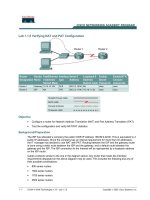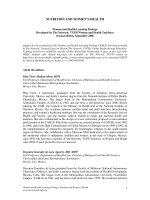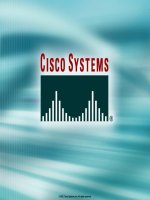Cisco Systems - Scaling the network with NAT and Pat pot
Bạn đang xem bản rút gọn của tài liệu. Xem và tải ngay bản đầy đủ của tài liệu tại đây (648.01 KB, 21 trang )
© 2002, Cisco Systems, Inc. All rights reserved.
© 2002, Cisco Systems, Inc. All rights reserved. ICND v2.0—6-2© 2002, Cisco Systems, Inc. All rights reserved. 2
Scaling the Network with
NAT and PAT
© 2002, Cisco Systems, Inc. All rights reserved. ICND v2.0—6-3
Objectives
Upon completing this lesson, you will be able to:
•
Describe the features and operation of NAT on Cisco
routers
•
Use Cisco IOS commands to configure NAT, given a
functioning router
•
Use show commands to identify anomalies in the NAT
configuration, given an operational router
•
Use debug commands to identify events and
anomalies in the NAT configuration, given an
operational router
© 2002, Cisco Systems, Inc. All rights reserved. ICND v2.0—6-4
Network Address Translation
•
An IP address is either local or global.
•
Local IP addresses are seen in the inside network.
© 2002, Cisco Systems, Inc. All rights reserved. ICND v2.0—6-5
Port Address Translation
© 2002, Cisco Systems, Inc. All rights reserved. ICND v2.0—6-6
Translating Inside Source Addresses
© 2002, Cisco Systems, Inc. All rights reserved. ICND v2.0—6-7
Configuring Static Translation
•
Establishes static translation between an inside local address
and an inside global address
Router(config)#ip nat inside source static local-ip global-ip
•
Marks the interface as connected to the inside
Router(config-if)#ip nat inside
•
Marks the interface as connected to the outside
Router(config-if)#ip nat outside
© 2002, Cisco Systems, Inc. All rights reserved. ICND v2.0—6-8
Enabling Static NAT
Address Mapping Example
© 2002, Cisco Systems, Inc. All rights reserved. ICND v2.0—6-9
Configuring Dynamic Translation
•
Establishes dynamic source translation, specifying the access
list defined in the prior step
Router(config)#ip nat inside source list
access-list-number pool name
•
Defines a pool of global addresses to be allocated as needed
Router(config)#ip nat pool name start-ip end-ip
{netmask netmask | prefix-length prefix-length}
•
Defines a standard IP access list permitting those inside local
addresses that are to be translated
Router(config)#access-list access-list-number permit
source [source-wildcard]
© 2002, Cisco Systems, Inc. All rights reserved. ICND v2.0—6-10
Dynamic Address Translation Example
© 2002, Cisco Systems, Inc. All rights reserved. ICND v2.0—6-11
Overloading an Inside Global Address
© 2002, Cisco Systems, Inc. All rights reserved. ICND v2.0—6-12
Configuring Overloading
•
Establishes dynamic source translation, specifying the access
list defined in the prior step
Router(config)#ip nat inside source list
access-list-number interface interface overload
•
Defines a standard IP access list permitting those inside local
addresses that are to be translated
Router(config)#access-list access-list-number permit
source source-wildcard
© 2002, Cisco Systems, Inc. All rights reserved. ICND v2.0—6-13
Overloading an Inside
Global Address Example
© 2002, Cisco Systems, Inc. All rights reserved. ICND v2.0—6-14
Clearing the NAT Translation Table
•
Clears a simple dynamic translation entry containing an inside
translation, or both inside and outside translation
Router#clear ip nat translation inside global-ip
local-ip [outside local-ip global-ip]
•
Clears all dynamic address translation entries
Router#clear ip nat translation *
•
Clears a simple dynamic translation entry containing an outside translation
Router#clear ip nat translation outside
local-ip global-ip
•
Clears an extended dynamic translation entry
Router#clear ip nat translation protocol inside global-ip
global-port local-ip local-port [outside local-ip
local-port global-ip global-port]
© 2002, Cisco Systems, Inc. All rights reserved. ICND v2.0—6-15
Displaying Information with show
Commands
•
Displays translation statistics
Router#show ip nat statistics
•
Displays active translations
Router#show ip nat translations
Router#show ip nat translation
Pro Inside global Inside local Outside local Outside global
172.16.131.1 10.10.10.1
Router#show ip nat statistics
Total active translations: 1 (1 static, 0 dynamic; 0 extended)
Outside interfaces:
Ethernet0, Serial2.7
Inside interfaces:
Ethernet1
Hits: 5 Misses: 0
…
© 2002, Cisco Systems, Inc. All rights reserved. ICND v2.0—6-16
Sample Problem: Cannot
Ping Remote Host
© 2002, Cisco Systems, Inc. All rights reserved. ICND v2.0—6-17
Solution: New Configuration
© 2002, Cisco Systems, Inc. All rights reserved. ICND v2.0—6-18
Using the debug ip nat Command
Router#debug ip nat
NAT: s=192.168.1.95->172.31.233.209, d=172.31.2.132 [6825]
NAT: s=172.31.2.132, d=172.31.233.209->192.168.1.95 [21852]
NAT: s=192.168.1.95->172.31.233.209, d=172.31.1.161 [6826]
NAT*: s=172.31.1.161, d=172.31.233.209->192.168.1.95 [23311]
NAT*: s=192.168.1.95->172.31.233.209, d=172.31.1.161 [6827]
NAT*: s=192.168.1.95->172.31.233.209, d=172.31.1.161 [6828]
NAT*: s=172.31.1.161, d=172.31.233.209->192.168.1.95 [23313]
NAT*: s=172.31.1.161, d=172.31.233.209->192.168.1.95 [23325]
© 2002, Cisco Systems, Inc. All rights reserved. ICND v2.0—6-19
Translation Not Installed in the
Translation Table?
•
Verify that:
–
The configuration is correct.
–
There are not any inbound access lists denying the
packets from entering the NAT router.
–
The access list referenced by the NAT command is
permitting all necessary networks.
–
There are enough addresses in the NAT pool.
–
The router interfaces are appropriately defined as NAT
inside or NAT outside.
© 2002, Cisco Systems, Inc. All rights reserved. ICND v2.0—6-20
Summary
•
Cisco IOS NAT allows an organization with unregistered
private addresses to connect to the Internet by translating
those addresses into globally registered IP addresses.
•
You can translate your own IP addresses into globally unique
IP addresses when communicating outside of your network.
•
Overloading is a form of dynamic NAT that maps multiple
unregistered IP addresses to a single registered IP address
(many-to-one) by using different ports, known also as PAT.
•
Once you have configured NAT, verify that it is operating as
expected using the clear and show commands.
•
Sometimes NAT is blamed for IP connectivity problems when
there is actually a routing problem.









